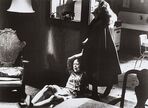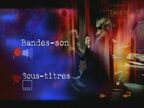Among the girls who teased Jiali, Su and Chris represented two different plot developments: one was to help her (Su felt sorry for Jiali, and wanted to make this lonely girl cheerful, Let her boyfriend Tommy invite her to the school dance party); the other is to retaliate against her (Chris and her boyfriend Billy poured pig blood on Carrie's head at the dance party to humiliate her, so that she could never lift her head. ).
Carrie, who was mocked at the ball, was enraged, and she used her superpowers to bloodbath the entire ball. "Blood" became the theme of this movie. The "menstrual blood" from the beginning of the movie represented Jiali's transformation from a girl to a woman, and also triggered her hidden superpowers; the female classmate's "pig blood" mocked the seriousness of the situation. To the peak, which also led to a disaster.
Jia Li was ridiculed and teased by the girls because she had her first menstrual cramp but she did not know why. After returning home, she was vilified by her mother: "That snake is called sin, and the hand of sin is intercourse.", her mother Fearing that her child would interact with other boys, she compared "menstrual blood" to disaster and "coitus" to the devil. When she realized the superpowers her daughter possessed, she compared it to "That is the power of Satan." Ke Jiali said that it was herself, not a devil, which was actually a confrontation between idealism and materialism. Jiali’s mother and her husband were very pious towards Christianity when they were young, and even had a desire for sex. But after a drunkenness, her husband couldn’t control his emotions and tainted her, so the mother gave birth to Jiali. She felt that this was God. For her punishment, she wanted to dedicate Jiali to God at the beginning, but she didn't do anything because of her soft heart. This time she tried to kill Jiali with a knife while holding Jiali, who had just been psychologically traumatized at the prom, in her arms. The stabbed Jiali inspired her super powers because of her unintentional anger. The flying knife and fork shot into the mother's body and stared at the door. This posture was exactly the same as the position of the body where the knife and fork were inserted and the image of Jesus in the house. Here should be a metaphor for the mother as a "god" and Jiali as a "devil". The devil defeated the gods, and the killing of the mother was condemned by the heavens. A "stone rain" came up from the sky and the house was removed and destroyed. Jiali and her mother Burial in the flames.
The lens in the movie is also worthy of research, and Brian de Palma once again demonstrated his extraordinary lens processing method. There are three scenes that impressed me the most in the film: the
first appeared in the dance of Carrie and Tom. DePalma should have kissed the hero and heroine from Hitchcock's "Vertigo" for several weeks. Rotate the inspiration obtained there, and carry forward it, where the degree of rotation is up to five minutes, and the frequency is getting faster and faster, the music is gradually disappearing, and finally people feel dizzy. Brian De, Palma has repeatedly used this 360-degree clockwise rotation technique many times, in "Fantasy", "Cruel Line", "Stand-in" (Pink Murder Night), "Snake Eye" It is used in other films.
The second part is the explanation method when introducing the relationship between rope, pig blood, and Jiali. A long lens shows these three relationships one by one. The camera follows the roof and shoots the bucket with pig blood on Jiali’s head. Opposing positions, and then a piece of paper fell from above and floated onto Jiali's head, suggesting that disaster is coming. That rope has also become the fuse of disaster. Su discovered that she tried to stop but was thought by the teacher that she was deliberately sabotaging. The entire paragraph is performed in slow motion, and there is no dialogue in all paragraphs, and a very suspenseful atmosphere can be immediately set off. This atmosphere is broken until the pig's blood is poured. This kind of slow motion processing is also profound in "Furious".
In the third place, immediately after the pig's blood was poured, Jiali used her superpowers to retaliate against the students who mocked and teased her. The screen is divided into two to explain the relationship between Jiali and these students, and the left and right sides continue to alternate between Jiali's use of superpowers and the students and teachers in suffering. The contrast is obvious and the atmosphere of terror can be more prominent. The screen division appears many times in the film, but here is a direct one. There are also some indirect screen divisions that have appeared in the film many times, and some close-up and long-distance scenes, and the interaction between inside and outside the window are also repeated in the film. This is also one of the hallmarks of DePalma's movies.
There are many tricks in the movie that are very special. For example, Jiali attends a dance party, her mother is holding a kitchen knife to chop carrots at home, the camera is shot with the top shot, the shot is disconnected, the top shot close-up is switched off, and the knife is closer again, and so on. There is a feeling of "cutting the mess with a quick knife" in the quick editing; after the pig blood is poured on Jiali's head, she has a dizzy effect, and the screen is processed into multiple screens that are rotated and overlapped, like a kaleidoscope. Everyone’s ridicule turned into an ugly state in the kaleidoscope; at the end of the movie, Su went to Jiali’s tombstone to visit. In order to show Su’s weird actions, the director asked Su to walk backwards backwards during filming, and then put them upside down. In the movie, it becomes walking forward, so the walking posture will feel weird. Here we can clearly see that the two surrounding vehicles are driving backwards. After the opening tennis match, the girls went to the locker room. There were naked, semi-naked, and underwear. They used slow motion + long camera to advance to Jiali in the shower. The whole picture and music reached a harmonious atmosphere. , The shot is very beautiful.
Finally, after Jiali and her mother were buried in the sea of flames, Su went to Jiali’s intended visit to show a slightly strange atmosphere, and then a bloody hand stretched out from the grave and grabbed Su’s arm, and Su was awakened from the dream. My mother also grabbed Su by the arm and told her "It's okay, it's okay." This horrible parallel montage made me unforgettable after watching it. This kind of false and real nightmare ending also appeared in the director's later "Razor's Edge", and it was carried forward more extensively in "The Femme Beauty".
DePalma’s films often show people who take the blame, and this film is no exception. If it weren’t for the girls who mocked Carrie at the time, it might not have ended like this. If Chris and Billy didn’t play pranks on Carrie. Perhaps there will be no such ending, these have become inevitable karma.
After having a close relationship with the music scorer Bernard Herman ("Funny Cases" in 1973, "Fantasy" in 1976), Herman passed away in 1976 and got Palmer. He had to find another scorer who was good at some horror films, so he found the Italian soundtrack person Pino Don Agio. Don Agio was an Italian smash hit singer in the 1950s, and later began to compose for movies, including Vis in the early days. Kandy’s "Leo Constellation" did not become famous until the early 1970s. The famous work of "The Witch Carrie" was "Don't Watch Now" (1973). This time it was him and Brian De Palma. They collaborated for the first time, and since then, they have cooperated for six times, and they are all suspense thrillers except for the 1979 "Family Movie", including the very representative "Razor's Edge" (1980). DePalma's next filming task-the horror film "Toy Man" will also be scored by Dontaggio.
It is also worth mentioning that the child who rode a bicycle and laughed at Carrie was the director’s nephew; and Nancy Allen, who played Chris, later became the director’s wife, and the two divorced. Palma collaborated for the first time, and the two later collaborated on "Family Movies", "Razor's Edge" and "The Furious Line". Amy Irene, who played Sue, later also played a heroine with superpowers in "Fury"; John Travolta, who played Billy, was not famous at the beginning, and a year later, because of "Weekend Dance" and Two years later, "Grease" became a famous dancer, and he later became the male protagonist in "Furious Line".
Published on August 28, 2005
View more about Carrie reviews










